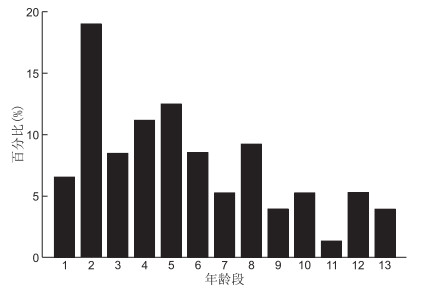Analysis on clinical characteristics and laboratory examination of Epstein-Barr virus infection in hospitalized children at different age stages
-
摘要:
目的 通过对153例EB病毒感染住院患儿临床资料进行回顾性分析,探讨不同年龄阶段EB病毒感染患儿临床表现及实验室检查特点。 方法 选择2012年1月—2020年1月蚌埠医学院第一附属医院儿科收治的153名EB病毒感染住院患儿的临床资料,根据年龄将其分为3组,分别为婴幼儿期组(1个月~3岁)52例,学龄前期组(3~7岁)57例,学龄期组(7~14岁)44例,对各组患儿的一般资料、临床表现及实验室检查结果进行分析。 结果 发病季节以春夏为主,呈夏高冬低趋势,分别为夏季66例(43.2%),秋季32例(20.9%),春季43例(28.1%),冬季12例(7.8%)。在疾病谱分布中,以传染性单核细胞增多症为主,共62例(40.5%);婴幼儿期组疾病更具有多样性,支气管肺炎、支气管炎等呼吸道疾病亦高发,少数患儿仅仅表现为腮腺肿大。临床表现中,婴幼儿组患儿咳嗽25例(48.1%)、皮疹14例(26.9%),较学龄前期组及学龄期组患儿高;学龄前期组淋巴结肿大36例(63.2%),学龄期组淋巴结肿大26例(59.1%),较婴幼儿组高;婴幼儿组无热有18例(72.0%),较其他2组高,高热有7例(16.7%),较其他2组低。实验室检查显示,谷丙转氨酶(ALT)升高者93例,婴幼儿组ALT升高程度较学龄期组低(P<0.05)。 结论 不同年龄阶段儿童EBV感染后在疾病分布、临床表现及实验室检查中各有特点,掌握不同年龄阶段疾病特点,有助于疾病的早期发现、早期诊断及早期治疗。 Abstract:Objective To explore the clinical features and in laboratory examination of children with EBV infection at different age stages. Methods The clinical data of 153 case hospitalized children with EBV infection from January 2012 to January 2020 in the First Affiliated Hospital of Bengbu Medical Collage were collected. All Patients were divided three groups, the infant and toddler period group (1 month to 3 years old, 52 cases), the preschool period group (3-7 years old, 57 cases), and the school-age period group (7-14 years old, 44 cases). The general data, clinical manifestations and laboratory examination results of children in each group were analyzed, and the characteristics were found and summarized. Results The onset season was dominated by spring and summer, and high in summer and low in winter, respectively, 66 cases (43.1%) in summer, 32 cases (20.9%) in autumn, 43 cases (28.1%) in spring, and 12 cases (7.8%) in winter. In the spectrum of disease, the infectious mononucleosis predominates had 62 case (40.5%). Diseases were more diverse in the infant and toddler period group, and they had high incidence of respiratory diseases such as bronchopneumonia and bronchitis, some rare cases of parotid gland enlargement. In clinical manifestation, there were 25 cases of cough (48.1%) and 14 cases of rash (26.9%) in the infant and toddler period group, higher than those in the preschool period group and school-age group (all P < 0.05). The lymphadenectasis in preschool period group had 36 case (63.2%) and in the school-age group has 26 case (59.1%), higher than those in the infant and toddler period group (all P < 0.05). The proportion of apyrexia in the infant and toddler period group had 18 cases (72.0%), higher than that in the other two groups, and hyperpyrexia had 7 cases (16.7%), lower than that in the other two groups (all P < 0.05). In the laboratory examination, there were 93 case patients increased in ALT, the ALT level of the infant and toddler period group was lower than that of the preschool period group. The difference was statistically significant (all P < 0.05). Conclusion Children who infect EBV at different ages are not totally identical in disease spectrum distribution, clinical manifestation and laboratory examination. So, mastering the characteristics of diseases at different age stages is conducive to early detection, early diagnosis and early treatment of diseases. -
表 1 153例EBV感染患儿相关疾病谱分布(例)
诊断 年龄分组 总计 婴幼儿 学龄前期组 学龄期组 传染性单核细胞增多症 13 27 22 62 支气管肺炎 7 5 4 16 支气管炎 3 4 2 9 咽扁桃体炎 2 4 2 8 病毒性脑炎 3 6 6 15 感染性发热 0 3 0 3 败血症 3 0 0 3 粒细胞减少 2 3 2 7 淋巴细胞增多症 3 0 0 3 血小板减少症 2 0 2 4 噬血细胞综合征 2 1 0 3 单纯性肝损伤 7 0 0 7 淋巴结炎 1 2 2 5 腮腺肿大 3 0 0 3 心肌炎 1 2 2 5 总计 52 57 44 153 表 2 3组患儿EBV感染后临床表现(例)
年龄分组 临床表现 发热 咽峡炎 淋巴结肿大 皮疹 肝脾肿大 眼睑水肿 咳嗽 三联征 婴幼儿组 34 33 20 14 16 6 25 15 学龄前期组 48 46 36 4 13 8 11 29 学龄期组 36 34 26 2 14 2 8 24 总计 118 113 82 20 43 16 44 68 χ2值 6.234 3.889 7.419 13.433 1.275 2.486 14.365 7.897 P值 0.044 0.143 0.024 0.001 0.529 0.288 0.001 0.019 表 3 3组患儿EBV感染后发热程度(例)
年龄分组 发热程度 无热 低热 中热 高热 婴幼儿组 18 10 17 7 学龄前期组a 9 5 21 22 学龄期组 8 9 14 13 总计 25 24 52 42 注:3组发热程度例数比较,H=12.353, P=0.002;与婴幼儿组比较,aPv0.05。 表 4 3组EBV感染患儿肝功能升高程度(例)
年龄分组 肝功能 轻度升高(40~100 U/L) 中度升高(100~400 U/L) 重度升高(>400 U/L) 婴幼儿组 12 13 0 学龄前期组 10 25 3 学龄期组a 3 23 4 总计 25 61 7 注:3组ALT升高程度例数比较,H=11.701, P=0.003;与婴幼儿组比较,aP < 0.05。 -
[1] 中华医学会儿科学分会感染学组, 全国儿童EB病毒感染协作组. 儿童主要非肿瘤性EB病毒感染相关疾病的诊断和治疗原则建议[J]. 中华儿科杂志, 2016, 54(8): 563-568. doi: 10.3760/cma.j.issn.0578-1310.2016.08.002 [2] WANG J, LUO Y, BI P, et al. Mechanisms of Epstein-Barr virus nuclear antigen 1 favor Tregs accumulation in nasopharyngeal carcinoma[J]. Cancer Med, 2020, 9(15): 5598-5608. doi: 10.1002/cam4.3213 [3] ANDREI G, TROMPET E, SNOECK R. Novel therapeutics for Epstein-Barr virus[J]. Molecules, 2019, 24(5): 997. doi: 10.3390/molecules24050997 [4] BEDRI S, SULTAN A A, ALKHALAF M, et al. Epstein-Barr virus (EBV) status in colorectal cancer: a mini review[J]. Hum Vaccin Immunother, 2019, 15(3): 603-610. doi: 10.1080/21645515.2018.1543525 [5] KATAHIRA Y, HIGUCHI H, MATSUSHITA H, et al. Increased granulopoiesis in the bone marrow following Epstein-Barr virus infection[J]. Sci Rep, 2019, 9(1): 13445. doi: 10.1038/s41598-019-49937-w [6] AYEE R, OFORI M E O, WRIGHT E, et al. Epstein Barr virus associated lymphomas and epithelia cancers in humans[J]. J Cancer, 2020, 11(7): 1737-1750. doi: 10.7150/jca.37282 [7] 吴丽芷, 陈始明. 鼻咽癌放疗抵抗机制的研究进展[J]. 山东医药, 2020, 60(12): 102-105. doi: 10.3969/j.issn.1002-266X.2020.12.028 [8] 顾岚, 王叶红. 小儿肝功能异常的临床分析[J]. 儿科药学杂志, 2012, 18(11): 7-9. doi: 10.3969/j.issn.1672-108X.2012.11.003 [9] 杨辅直, 李伟生, 张倩, 等. 小儿EB病毒感染的临床治疗分析[J]. 中华医院感染学杂志, 2016, 26(24): 5707-5709. https://www.cnki.com.cn/Article/CJFDTOTAL-ZHYY201624063.htm [10] WINTER J R, TAYLOR G S, THOMAS O G, et al. Predictors of Epstein-Barr virus serostatus in young people in England[J]. BMC Infect Dis, 2019, 19(1): 1007. doi: 10.1186/s12879-019-4578-y [11] 谢利波, 刘敏, 王敏. 975例儿童EB病毒感染状况分析[J]. 巴楚医学, 2018, 1(3): 80-83. https://www.cnki.com.cn/Article/CJFDTOTAL-BMJJ201803017.htm [12] 孙倩, 田居灵, 钟良英. 不同年龄儿童EB病毒感染状况分析[J]. 现代医药卫生, 2019, 35(24): 3768-3770. https://www.cnki.com.cn/Article/CJFDTOTAL-XYWS201924014.htm [13] 刘立飞, 周凯, 胡静. 不同年龄段儿童原发性EB病毒感染发病的临床特点[J]. 实用医学杂志, 2017, 33(9): 1471-1474. doi: 10.3969/j.issn.1006-5725.2017.09.028 [14] 张建华, 孙静怡, 陈梦雪. 儿童EB病毒感染及呼吸系统相关性疾病[J]. 中华实用儿科临床杂志, 2019, 34(10): 725-729. doi: 10.3760/cma.j.issn.2095-428X.2019.10.002 [15] 王超颖, 方洁, 郭盛, 等. 肺炎支原体肺炎合并EB病毒感染41例临床分析[J]. 中华全科医学, 2016, 14(8): 1252-1254, 1398. https://www.cnki.com.cn/Article/CJFDTOTAL-SYQY201608004.htm [16] FUGL A, ANDERSEN C L. Epstein-Barr virus and its association with disease - a review of relevance to general practice[J]. BMC Fam Pract, 2019, 20(1): 62. doi: 10.1186/s12875-019-0954-3 [17] DEVKOTA K, HE M, LIU M Y, et al. Increasing Epstein-Barr virus infection in Chinese children: A single institutional based retrospective study[J]. F1000Res, 2018, 7: 1211. doi: 10.12688/f1000research.15544.1 [18] 吉征喜, 孙祖银, 姚劲. 儿童EB病毒混合感染70例临床分析[J]. 国际儿科学杂志, 2018, 45(12): 984-986. doi: 10.3760/cma.j.issn.1673-4408.2018.12.021 [19] DUNMIRE S K, HOGQUIST K A, BALFOUR H H. Infectious mononucleosis[J]. Curr Top Microbiol Immunol, 2015, 390(Pt 1): 211-240. [20] 叶翠燕, 苏宝凤. 传染性单核细胞增多症患儿外周血淋巴细胞亚群及自然杀伤细胞的变化及临床意义[J]. 中国医药, 2019, 14(12): 1830-1833. doi: 10.3760/j.issn.1673-4777.2019.12.017 [21] 姚艳青, 崔红. 80例不同年龄儿童EB病毒相关性传染性单核细胞增多症的临床特点分析[J]. 中国医刊, 2017, 52(8): 76-79. doi: 10.3969/j.issn.1008-1070.2017.08.022 [22] 谢正德. EB病毒感染与儿童肝损害[J]. 临床肝胆病杂志, 2012, 28(12): 893-895. doi: 10.3969/j.issn.1001-5256.2012.12.004 [23] 钟绍文, 刘泽, 司秋圆, 等. EB病毒感染与儿童肝损害研究[J]. 临床医药文献电子杂志, 2019, 6(96): 187-188. https://www.cnki.com.cn/Article/CJFDTOTAL-LCWX201996156.htm -





 下载:
下载:


